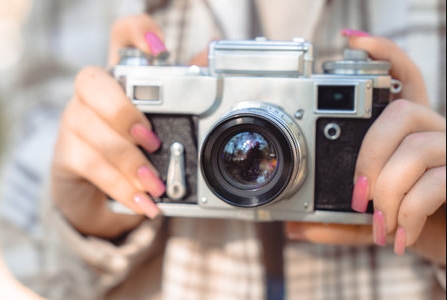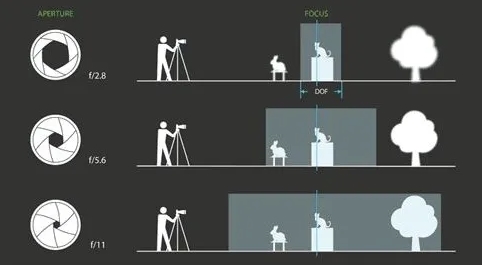Aperture is also known as F-Stocking and is the most important camera setting in photography.
Aperture is one of the most important tools for artistic expression in photography, and mastering this setting gives you a wide range of motion when capturing perfect shots.
In photography, the foundation of creating impressive images is the exposure trinity: aperture, shutter speed, and ISO. A balanced interaction between these three components is essential for a perfectly exposed photograph. When any element of the exposure trinity changes, the other two must adapt. Of these trinity, aperture plays the most critical role in determining the final appearance of your photograph.

- What is the Diaphragm?
- How to Measure Aperture?
- What is F-Stop?
- How to Set Aperture on Your Camera
- 2 Advantages of Manually Controlling the Diaphragm
- What is the Relationship Between Shutter Speed and Aperture?

What is the Diaphragm?
Aperture means opening. In photography, aperture refers to the hole in the center of a camera lens that allows light to pass onto the image sensor of a digital camera or the film strip in a film camera. The aperture consists of a series of interlocking metal blades that open and close like an iris. Both the aperture and the shutter are the same mechanism; they both open and close when you press the shutter button. Shutter speed determines how long the aperture remains open.
You control the size of your camera's aperture by turning the ring around the lens to open the aperture wider or smaller. This affects how much light touches the sensor; a larger aperture lets in more light, while a smaller aperture lets in less.

How to Measure Aperture?
Aperture is expressed as a fraction measured in f-stops. A lower f-stop, or f-number, indicates a wider aperture, while a higher f-stop indicates a narrower aperture. Just as ½ is a larger quantity than ¼, f/2 is wider than f/4. Both are wider than f/16.
There are many different lenses with different apertures, but a basic camera lens will accommodate f-numbers in this range:
f/1.4
f/2
f/2.8
f/4
f/5.6
f/8
f/11
f/16
f/22
What is F-Stop?
F-numbers are the mathematical relationship between your camera's focal length and the size of your aperture:
Focal Length / Diameter of Aperture = F-Stop
This means that aperture will remain consistent across different cameras and focal lengths; the same f-stop will create the same exposure no matter your camera's focal length.
For example, let's say you have two cameras: one with a 90mm focal length and the other with a 60mm focal length. An f/4 aperture setting on a 90mm lens creates an aperture of 22.5mm (one-quarter of the focal length), while the same aperture on a 60mm lens creates an aperture that's 15mm wide (still one-quarter of the focal length). Both cameras will produce exactly the same image with the same depth of field and exposure, as long as the shutter speed and ISO remain consistent.
How to Set Aperture on Your Camera
You can manually adjust the aperture on your digital camera in two ways:
Manual Mode: Labeled "M" on the top dial on most cameras, it takes your camera out of automatic mode. In this mode, you also have control over the shutter speed.
Aperture priority mode: This is marked "A" or "Av" on your camera. In this mode, your camera automatically adjusts the shutter speed based on the aperture you select.
On some cameras, you select the aperture on the screen. On other cameras, you select the aperture on the lens.
2 Advantages of Manually Controlling the Diaphragm
Manually controlling the size of your camera's aperture allows you to control two things: exposure and depth of field.
Exposure : The amount of light entering your camera. Manually controlling your aperture allows you to adjust exposure and image brightness beyond what your camera's automatic settings allow. If you're photographing in the dark, you can choose a lower f-stop—opening your aperture wider—to ensure your image isn't underexposed (too dark). If you're photographing in a location with a lot of light, you'd do the opposite—choose a higher f-stop, closing the aperture—to ensure your image isn't overexposed.
Depth of field : How much of your image will be in focus. Adjusting the aperture also controls depth of field, which determines how much of your image will be in focus.
Deep depth of field means that almost everything in your image will be sharply focused, from the near foreground to the distant background. Think of a simple phone camera, where everything in the image is sharp and in focus, even things in the distance. When photographing wide landscapes, such as landscapes and city skylines, where you want everything in focus, use a narrow aperture to achieve deep depth of field.
Shallow depth of field means that only the subject is in focus, while the rest of the image is out of focus. For example, some phone cameras have a portrait mode that alters the depth of field so that the foreground is in focus and the background is not. When taking a portrait photo against a busy background, use a wide aperture to achieve shallow depth of field, so the subject is in focus and the background is blurred to avoid distracting the viewer.
What is the Relationship Between Shutter Speed and Aperture?
You can also adjust your aperture depending on your shutter speed.
Compensate for a fast shutter speed : A fast shutter speed will prevent motion blur or capture fast action clearly, but it won't let as much light in. You can compensate for this decreased light by using a larger aperture (remember, a lower f-stop) to let in more light.
Compensate for slow shutter speed : A slow shutter speed lets in a lot of light and can be used to capture an image in low light without flash or to blur the motion of a moving subject. You can compensate for this increased light by using a smaller aperture (higher f-stop) to ensure your image isn't overexposed.



SHARE:
Photography Lighting Principles